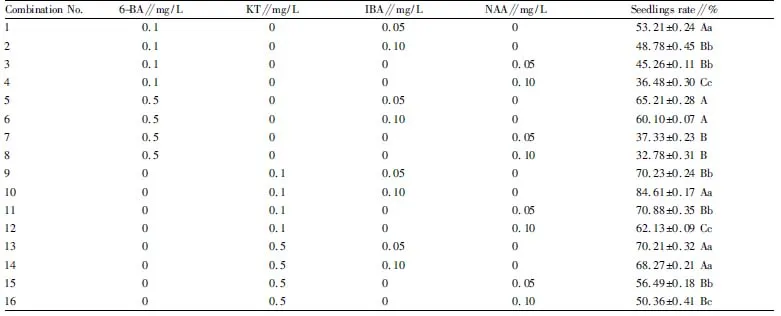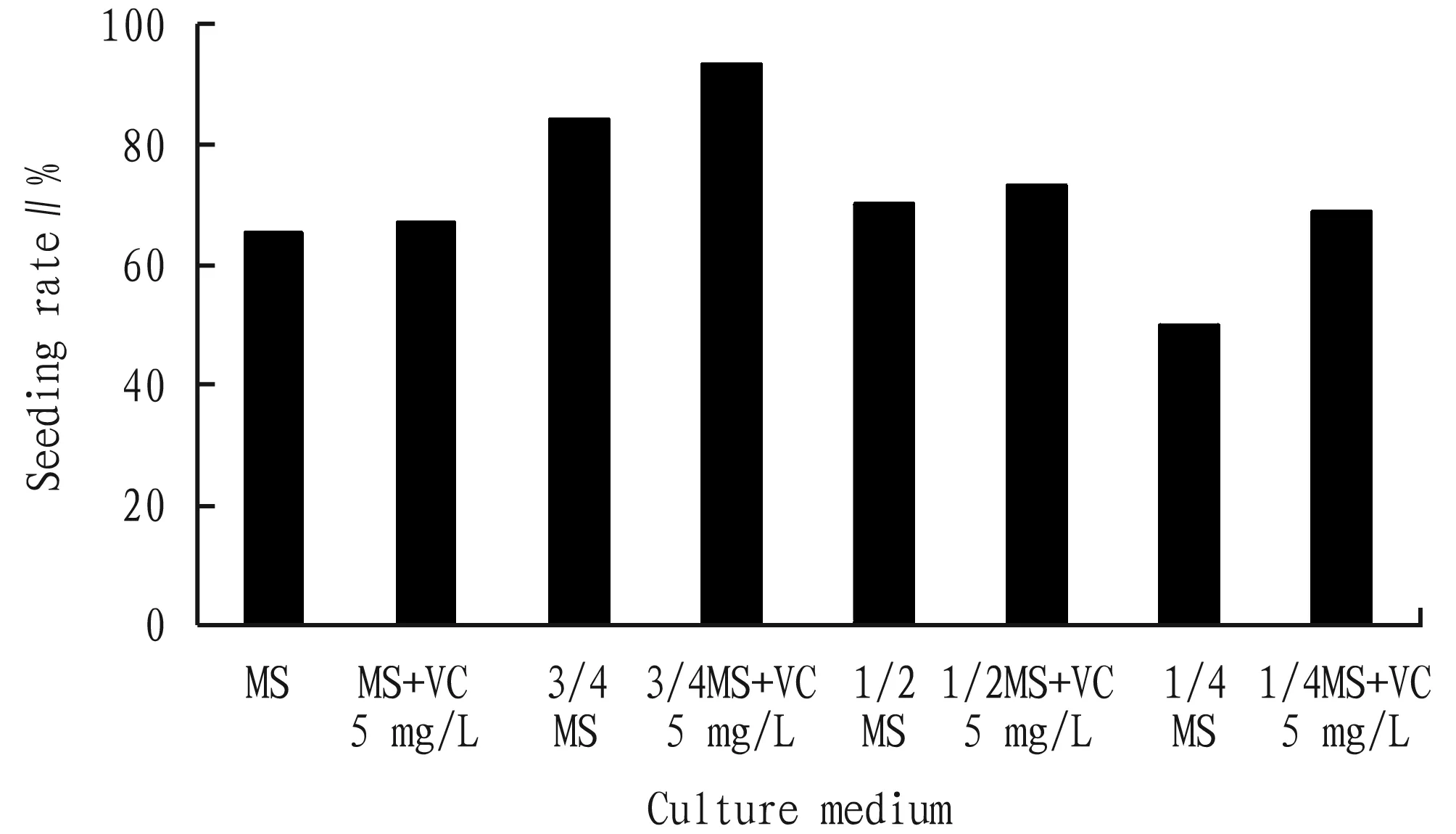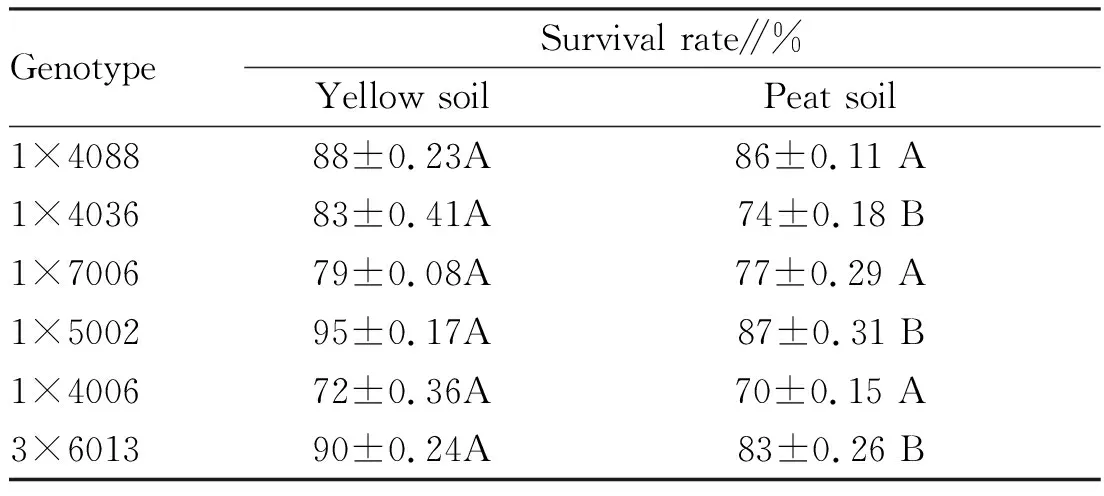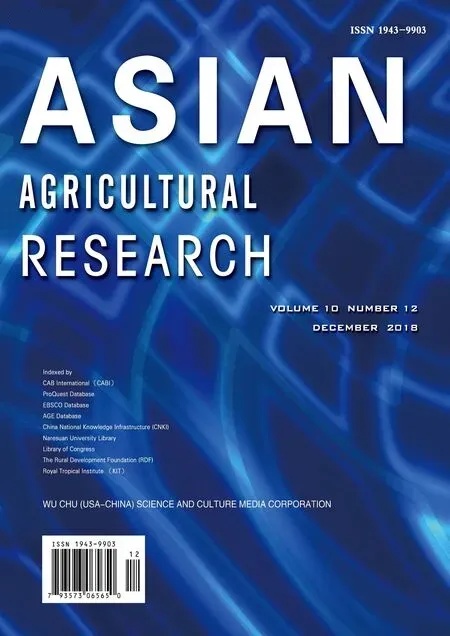Optimization of Germinated Conditions for Somatic Embryos in Liriodendron Hybrids
2019-01-14,
,
1. Department of Biological Technology, Nanchang Normal University, Nanchang 330032, China; 2. Jiangxi Provincial Key Lab for Plant Biotechnology, Jiangxi Academy of Forestry, Nanchang 330013, China
Abstract The development of somatic embryos is a key technology in plant breeding. To gain the best cultural conditions, the factors influencing on germination and transplanting survival rate of the somatic embryos in Liriodendron hybrids were optimized, including the development period of somatic embryos, macro-element, Vitamin C, genotypes, plant hormones and transplant medium in this study. The results showed that the optimal development phase of germination was torpedo-shaped embryo, and the base cultural medium of 3/4 MS with vitamin C can keep normal form from somatic embryos. The germination rate of somatic embryo had obvious genotype difference, among which the hybrid 1×5002 was the most sensitive (82.46%), and the hybrid 1×4088 was the most insensitive (13.24%). The medium with 0.1 mg/L of KT+0.1 mg/L of IBA can help promote the germination of somatic embryogenesis. In addition, the yellow soil was more suitable than mixed peat soil for transplanting Liriodendron hybrids seedlings. Therefore, the obtainment of the optimal conditions has important guidance for production practices of Liriodendron hybrids.
Key words Liriodendron hybrids; Somatic embryos; Germination
1 Introduction
Somatic embryogenesis has been considered as the most effective reproductive method of breeding woody plants[1]. In recent years, many scholars have undertaken extensive studies on the mechanism of plant somatic embryogenesis[2-4], and successfully established the breeding system of several important woody plants includingLiriodendronhybrids[5], Larix[6]and masson pine[7]. Germination of somatic embryo seedling is a key factor influencing somatic embryogenesis technologies ofLiriodendronhybrids in the course of factory production. However, few studies have been conducted on this effect. Therefore, we conducted an experiment to optimize the influencing factors ofLiriodendronhybrid embryo germination for large-scale production.
2 Materials and methods
2.1ExperimentalmaterialsThe experimental materials includedLiriodendronhybrid embryos of six genotypes, induced by the Key Laboratory of Forest Genetics and Biotechnology in Nanjing Forestry University. The concrete procedure of inducingLiriodendronsomatic embryo includes induction of embryogenic callus, regulation of embryonic cell callus, development of somatic embryogenesis, and plantlet regeneration[8-9]. The genotype of early cotyledon embryos obtained includes these genotypes: 1×5002, 1×4088, 1×4036, 1×7006, 1×4006, 3×6013.
2.2DevelopmentalphasesAccording to the developmental phases ofLiriodendronhybrid (Genotype 1×5002), the somatic embryos were divided into torpedo type embryos, early cotyledon embryos, mature cotyledon embryos (morphologically showing cotyledons turning green and marked hypocotyl elongation).
2.3HormonecombinationsThe hormone combination design of early cotyledonary embryos from genotype 1×5002 hybrid were conducted, including 6-benzylamino purine (6-BA) , kinetin (KT), indole acetic acid (NAA), and indole butyric acid (IBA).
2.4Largeamountofmacro-elementsandvitaminCinbasemediumThe early cotyledon embryo of 1×5002 hybrid was inoculated into the medium of MS, 3/4 MS, 1/2 MS, 1/4 MS and Vitamin C (Vc) combinations. According to the experimental design, other mediums were 3/4 MS+carrageenan (7 g/L)+sucrose (30 g/L), pH 5.6-5.8, culture temperature (25±2)℃, light period (14 h/d), light intensity (2 000 Lx). After one month, the survival rate of hybrid embryo seedling was counted with three repeats.
2.5TransplantingmethodThe hybrid somatic embryo seedlings were transplanted when they were rooting and the stem length was 2-3 cm. The trials of transplanting methods were compared between yellow soil and peat soil. In each experiment, 100 plants were transplanted and the survival rate was counted after one month.
2.6StatisticalanalysisAll data were subjected to statistical analysis using the SPSS17.0 software program. Analysis of variance (ANOVA) was performed using all the mean value of data at 1% probability level (P<0.01).
3 Results
3.1DevelopmentalphaseThe results (Table 1) showed that the germination rate of torpedo embryo was 76.32%, with robust plantlets, long stem pumping, normal leaf morphology; the seedling rate of early cotyledonary embryo was 60.02%, produced a few malformed seedlings, and showed malformed leaves, hypocotyl vitrification and the emergence of a large number of callus; meanwhile, the germination rate of mature cotyledon embryo seedling was the lowest (only 23.73%), and had serious vitrification, leaf malformation and a large amount of callus produced. Therefore, the torpedo embryo had been proved to be better for germination ofLiriodendronhybrid embryo.

Table 1 Comparison of germination ability of somatic embryos in different stages
Note: Data for the three combinations with a column followed by different small (capital) letters indicated significant differences among the three combinations at 5% (1%) probability levels, respectively. It was same in Table 2 and Table 3.
3.2GenotypeofcotyledonembryosUnder the same condition, the germination ability is different between several somatic embryos genotypes (Fig. 1). Genotype 1×5002 had the highest seedling rate of 84.26%, followed by 3×6013, the seedling rate was 67.14%, the lowest was 1×4088, and the seedling rate was only 13.24%. The seedling rates of genotypes 1×4088, 1×4036 and 1×7006 were below 35%, belonging to difficult seedling types; the seedling rates of genotypes 1×4036 and 3×6013 were 52.01% and 67.14%, respectively, belonging to intermediate seedling types; and the genotype of 1×5002 belonged to easy seedling type.
3.3HormonecombinationsongerminationabilityofleafembryoThe contrast experiment of different hormone combinations (Table 2) showed that in the combination of 6-BA and IBA, the rate of combination 2 into seedlings was the lowest (48.78%), and the rate of combination 5 was the highest (65.21%); in the combination of 6-BA and NAA, the combination 3 was the highest (45.26%), indicating that 6-BA and IBA promoted the germination of somatic embryos, obviously better than the combinations of 6-BA and NAA; in the combination of KT and IBA, the seedling percentage of combination 10 was the highest (84.61%), and the lowest was combination 12 (68.27%); in the combination of KT and NAA, the seedling percentage of combination 11 was the highest (70.88%), and the lowest was combination 16 (50.36%).

Fig.1 Comparison of genotypes of cotyledon embryo on seeding germination

Table 2 Effects of 6-BA, KT and NAA, IBA in different combinations of germination from somatic embryos
Therefore, the germination inLiriodendronhybrid plantlets cultured in IBA added is better than NAA added. And KT is more conducive than 6-BA to the promotion of embryo germination. So the optimal hormone combination is KT 0.1 mg/L+IBA 0.1 mg/L for the somatic seedlings germination ofLiriodendronhybrids.
3.4Macro-elementsandVconthegerminationabilityofcotyledonembryosThe results showed that the medium of 3/4 MS was the most suitable for the somatic embryo germination, the seedling rate was up to 84.26%. And macro-elements in the medium had significant effects on the germination of somatic embryos ofLiriodendronhybrids. Furthermore, the addition of 5mg/L Vc helped increase the seedling rate. And it was also found that Vc added can increase the normal growth of plantlets, reduce the seedling deformity and vitrification rate (Fig. 2). So, Vc played an important role in maintaining normal morphology ofLiriodendronhybrid plantlets, which was essential for organic ingredients in germination culture medium.

Fig.2 Effects of macro-elements and Vc of germination from somatic embryos
3.5ComparisonoftwokindsofmatrixefordifferentgenotypeembryoseedlingsThe transplanting matrix experiment (Table 3) showed that the plantlets survival rate of the genotype of 1 ×5002 and 3×6013 was the highest. And the yellow soil was more suitable than mixed peat soil for the survival and growth of plantlets.

Table 3 Comparison of transplanting survival rate of genotypes of somatic embryos seeding and two kinds of transplanting matrix
4 Discussions
This study explored the cultivation of somatic embryo germination inLiriodendronhybrids, the following questions should be considered during the breeding process. (i) The developmental stages had great relationship with the embryo germination efficiency (the torpedo embryo > the cotyledon embryo), which may be due to the cotyledon formation in cotyledon embryos absorbed nutrients, water, hormones and other substances of organ differentiation process, leading to the deformity, vitrification, callus growth and the seedling rate decline[1]; (ii) Vc had been proved to maintain the normal morphology of callus differentiation, seedling forming, andLiriodendronhybrid plantlets, which was an essential ingredient in the culture medium; (iii) The cultured condition of 5-10 d at 20℃ of 1 000 Lx, then transferring to 25℃ of 2 300 Lx can also reduce the deformity rate in the hybrid seedlings.
In summary, the optimal germination method ofLiriodendronhybrid plantlets is to choose the pale yellow somatic embryo under the phase from small torpedo to early cotyledonary embryo type firstly; inoculate on the sucrose culture medium of 3/4 MS + 0.1 mg/L of KT + 0.1 mg/L of IBA + 5mg/L of Vc + 30 g/L of sucrose with 5 d culture in 1 000 Lx at 20℃; and then transferred to the condition of 25℃ with 2 300 Lx can obtain the optimal effect of embryo germination ofLiriodendronhybrid .
杂志排行
Asian Agricultural Research的其它文章
- Effects of Different Times of Bagging on Fruit Quality and Disease and Pest Incidence of Fuji Apple
- Effects of Bio-organic Selenium on Agronomic Economic Traits and Selenium Absorption and Distribution in Rice
- Effects of Different Water-soluble Fertilizers on Yield and Quality of Strawberry under Integrated Application of Water and Fertilizer
- Land Use Analysis of Yichun-Wanzai Expressway
- MEC Based Study of Brand Building of Hongyue Garden Maker
- Effects of Human Capital Investment on Entrepreneurial Capability of New Generation of Migrant Workers
——An Empirical Study Based on Questionnaire Survey in Chongqing
